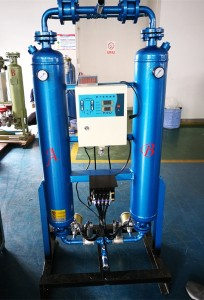A dryer refers to a mechanical device used to dry an object by using heat energy to reduce the moisture content of materials. The dryer evaporates the moisture in the material (generally refers to water and other volatile liquid components) by heating to get a solid material with a specified moisture content. The purpose of drying is to meet the needs of material use or further processing. Dryers are divided into two types, normal pressure dryers and vacuum dryers, depending on the working pressure. The working principles of adsorption dryers and freeze dryers are also introduced in detail.
1. Working Principle of Adsorption Air Dryer
The adsorption dryer achieves a drying effect by “pressure change” (principle of pressure fluctuation adsorption). Because air’s ability to hold water vapor is inversely proportional to pressure, some of the dry air (called regeneration air) is depressurized and expanded to atmospheric pressure. This pressure change causes the expanded air to dry further and flow through the unconnected air. In the regenerated desiccant layer (that is, the drying tower that has absorbed enough water vapor), the dry regeneration gas will absorb the moisture in the desiccant and take it out of the dryer to achieve the purpose of dehumidification. The two towers work in cycles without a heat source, continuously supplying dry, compressed air to the user’s gas system.
2. Operating principle of refrigerated air dryer
The refrigeration dryer is based on the principle of refrigeration dehumidification. The compressed gas discharged from the air compressor is cooled by a fully closed compression refrigeration system, and the large amount of saturated steam and condensed droplets of oil mist contained therein are separated. To do. Finally, discharged by an automatic drainer, the hot saturated compressed gas enters the precooler of the low temperature dryer, exchanges heat with the dry low temperature gas from the evaporator, and enters the evaporator of the cooling dryer. Cool the refrigeration system after lowering the temperature. A second heat exchange with the refrigerant vapor lowers the temperature to near the vaporization temperature of the refrigerant. During the two cooling processes, the water vapor in the compressed gas condenses into liquid water droplets that entrain the air stream into the steam separator where they are separated. The falling liquid water is discharged out of the machine through an automatic drainer, and the dry compressed gas whose temperature has dropped enters the pre-cooler and exchanges heat with the pre-cooler. Freshly entered moist saturated gas, which has increased its own temperature, provides a dry compressed gas with low moisture content (i.e. low dew point) and low relative humidity at the air outlet of the low temperature dryer. At the same time, make full use of the cold air source of the outlet air to ensure the condensation effect of the machine’s refrigeration system and the quality of the air at the machine’s outlet. Refrigeration dryers have become the first choice as purification equipment for air compressor stations in various industries due to their reliable operation, convenient management and low operating costs.
Post time: Sep-22-2023



